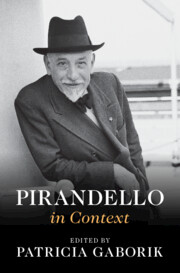Book contents
- Pirandello in Context
- Pirandello in Context
- Copyright page
- Dedication
- Contents
- Figures
- Contributors
- Preface
- Acknowledgments
- Chronology
- List of Cited Titles in Translation and the Original Italian
- Part I Places
- Part II Institutions
- Part III Interlocutors
- Part IV Traditions and Trends, Techniques and Forms
- Part V Culture and Society
- Chapter 25 History
- Chapter 26 Celebrity
- Chapter 27 Cinema
- Chapter 28 Modernity
- Chapter 29 Fascism
- Chapter 30 Women
- Chapter 31 Religion
- Chapter 32 Madness
- Chapter 33 Suicide
- Part VI Reception and Legacy
- Further Reading
- Index
Chapter 32 - Madness
from Part V - Culture and Society
Published online by Cambridge University Press: 14 March 2024
- Pirandello in Context
- Pirandello in Context
- Copyright page
- Dedication
- Contents
- Figures
- Contributors
- Preface
- Acknowledgments
- Chronology
- List of Cited Titles in Translation and the Original Italian
- Part I Places
- Part II Institutions
- Part III Interlocutors
- Part IV Traditions and Trends, Techniques and Forms
- Part V Culture and Society
- Chapter 25 History
- Chapter 26 Celebrity
- Chapter 27 Cinema
- Chapter 28 Modernity
- Chapter 29 Fascism
- Chapter 30 Women
- Chapter 31 Religion
- Chapter 32 Madness
- Chapter 33 Suicide
- Part VI Reception and Legacy
- Further Reading
- Index
Summary
Toward the close of the nineteenth century, a crisis of reason occurred, challenging positivist thought. Philosophy, psychology, and psychiatry were all asked to reexamine their conceptions of man and their scientific practices. The issue of subjectivity was explored not only through Freudian analysis, which was introduced at the end of the century, but also through other scientific methods, particularly French experimental psychology (Binet, Ribot, Richet) and hypnosis, which, despite its questionable scientific reliability, presented a new model of the mind and personality that was destined to be widely accepted beyond the sciences. These studies were at the forefront of scientific research. Luigi Pirandello engaged in both philosophical and scientific discourse, and his ideas and artistic works contributed to the deconstruction of traditional notions of self and identity, as seen in such works as One, No One, and One Hundred Thousand and Così è (se vi pare).
- Type
- Chapter
- Information
- Pirandello in Context , pp. 257 - 265Publisher: Cambridge University PressPrint publication year: 2024

